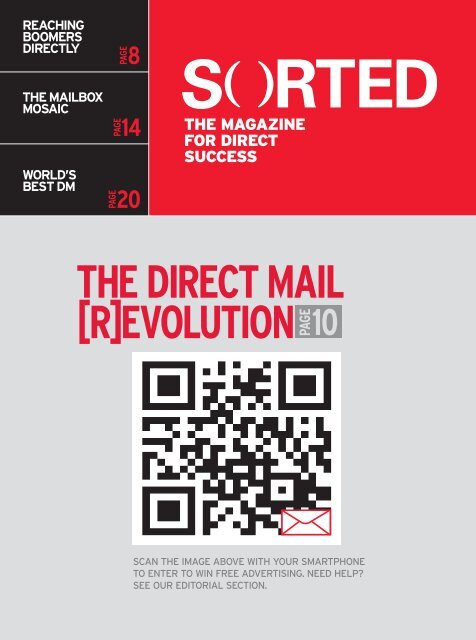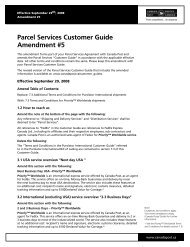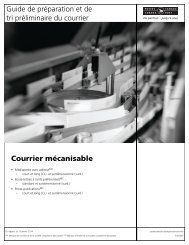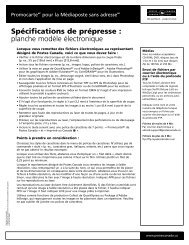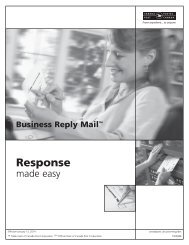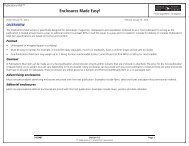Download as PDF - Canada Post
Download as PDF - Canada Post
Download as PDF - Canada Post
You also want an ePaper? Increase the reach of your titles
YUMPU automatically turns print PDFs into web optimized ePapers that Google loves.
REACHING<br />
BOOMERS<br />
DIRECTLY<br />
PAGE<br />
8<br />
THE MAILBOX<br />
MOSAIC<br />
WORLD’S<br />
BEST DM<br />
PAGE<br />
PAGE<br />
14<br />
20<br />
THE MAGAZINE<br />
FOR DIRECT<br />
SUCCESS<br />
THE DIRECT MAIL<br />
[R]EVOLUTION 10<br />
PAGE<br />
ada <strong>Post</strong><br />
ode English<br />
SCAN THE IMAGE ABOVE WITH YOUR SMARTPHONE<br />
TO ENTER TO WIN FREE ADVERTISING. NEED HELP?<br />
SEE OUR EDITORIAL SECTION.<br />
2011 edition I 1
<strong>Canada</strong> <strong>Post</strong><br />
EDITORIAL<br />
Over 150 years ago Charles Darwin introduced the world to<br />
evolution and the idea that species needed to adapt to survive.<br />
F<strong>as</strong>t forward to 2011 – incre<strong>as</strong>ed competition, fewer resources,<br />
and a rapidly changing landscape present the same challenges<br />
to marketers, and show that even we must evolve. Fortunately<br />
we have managed to keep pace, and in the following pages<br />
you’ll see how successful businesses are capitalizing on exciting<br />
opportunities and placing consumers at the center.<br />
As always, I encourage you to send any comments, suggestions<br />
or queries about any of the content in this year’s edition<br />
of Sorted to sorted@canadapost.ca. Our objective is to deliver<br />
compelling, actionable content that can help make you<br />
a better marketer.<br />
Thanks for reading,<br />
One of the important parts of marketing is understanding our<br />
customers’ needs and delivering on them. It sounds like<br />
child’s play, but the techniques marketers use to achieve this<br />
are becoming incre<strong>as</strong>ingly sophisticated. Improvements in data<br />
collection, research and analytics allow us to attain insights<br />
into customer behaviors and purch<strong>as</strong>ing patterns, which<br />
means that budgets and messages can be directed accordingly.<br />
At the same time, new tools, technologies and designs are<br />
capturing our customers’ attention and engaging them like<br />
never before. Our cover story (beginning on page 10) looks at<br />
how Direct Mail (DM) weaves all of these threads together<br />
code English<br />
to remain at the forefront. In fact, you can scan the QR code<br />
on the cover of this magazine to see how print integrates<br />
well with online.<br />
We consider Sorted to be a magazine of best practices, and<br />
we’re happy to share it with you. Within the following pages<br />
you’ll find out how DM serves <strong>as</strong> an effective solution for<br />
a wide variety of businesses. You’ll learn about the role it plays<br />
for organizations in the not-for-profit sector (page 19),<br />
how it’s allowing marketers to reach out to <strong>Canada</strong>’s incre<strong>as</strong>ingly<br />
multicultural community (page 14), and how segmentation<br />
and modeling helps us target those who will buy instead <strong>Canada</strong> of <strong>Post</strong><br />
those who can buy (page 5).<br />
QR code French<br />
In our 2010 issue we discussed green marketing, and we’ve<br />
taken that to heart. These pages demonstrate <strong>Canada</strong> <strong>Post</strong>’s<br />
continued commitment to environmental sustainability,<br />
<strong>as</strong> Sorted is printed on 30% recycled paper. We consider the<br />
magazine you hold in your hands proof that responsible<br />
direct marketers can make a significant difference without<br />
compromising the quality of their work.<br />
Laurene Cihosky<br />
Senior Vice-President, Direct Marketing<br />
Advertising & Publishing Business<br />
<strong>Canada</strong> <strong>Post</strong><br />
Sorted Magazine is produced on behalf of <strong>Canada</strong> <strong>Post</strong> by<br />
Adcam Media and Elvis Communications.<br />
President: Cameron Gardner, Adcam Media<br />
Editor: Chris Powell<br />
Creative Director: Diane Gagné<br />
Art Directors: Dave Laing, Agostino Gu<strong>as</strong>tella, Noel Naguiat<br />
Writers: Chris Daniels, Mara Gulens<br />
For information about how direct marketing can work for<br />
your company, contact <strong>Canada</strong> <strong>Post</strong> at 1 866 747-3880<br />
WWW.CANADAPOST.CA/DMEVOLUTION<br />
Contents Copyright © 2011 by <strong>Canada</strong> <strong>Post</strong>;<br />
may not be reprinted without permission.<br />
From the cover<br />
If you don’t have a scanner on your<br />
smartphone, download one for free at<br />
getscanlife.com (standard data rates apply).<br />
Or visit www.canadapost.ca/DMevolution<br />
for your chance to win.<br />
FPO – printer drops in
CONTENTS<br />
05<br />
THE SECRET OF SEGMENTATION<br />
07<br />
DM BY THE NUMBERS<br />
08<br />
REACHING BOOMERS DIRECTLY<br />
<strong>Canada</strong> <strong>Post</strong> <strong>Canada</strong> <strong>Post</strong><br />
QR code English QR code English<br />
10<br />
THE DM [R]EVOLUTION<br />
14<br />
THE MAILBOX MOSAIC<br />
16<br />
I’M WITH THE BRAND<br />
18<br />
DIRECT MAIL BEST PRACTICES<br />
DM<br />
<strong>Canada</strong> <strong>Post</strong> <strong>Canada</strong> <strong>Post</strong><br />
19<br />
ONE : ONE WITH JENNIFER SCHNARE<br />
QR code French QR code French<br />
20<br />
WORLD’S BEST DM<br />
22<br />
HOW DM MEASURES UP
4 I MAGAZINE
THE SECRET OF<br />
SEGMENTATION<br />
IN B2B, IT’S ALL ABOUT SEPARATING<br />
THE CAN BUYS FROM THE WILL BUYS.<br />
Cosmo Mariano says one of the biggest mistakes direct marketers in the B2B<br />
space make is “targeting prospects who can buy a product or service versus targeting<br />
those who will buy.” As partner of best practice demand generation firm Lift Agency,<br />
he says his agency is helping companies determine those customer segments<br />
who have the highest propensity to buy.<br />
2011 edition I 5
“The trend we are seeing is the execution of many smaller, highly<br />
targeted campaigns, versus generic batch-and-bl<strong>as</strong>t messaging to a<br />
large audience,” says Mariano. “The re<strong>as</strong>on for that is while it initially<br />
can cost more to execute a number of smaller campaigns which<br />
are highly targeted, in the end they yield the best results for your<br />
overall investment.”<br />
Still, he says it can be a tricky balance for B2B marketers.<br />
“If they target too narrowly, they’ll starve their sales force of leads,”<br />
says Marino. “But if they target too broadly, they will overwhelm<br />
and frustrate their sales force with too many markets to be experts<br />
in and will end up with poor quality leads that in the end are<br />
unlikely to close.”<br />
some leads may be best nurtured through a combination of e-mail<br />
and direct mail, while others having already received some direct<br />
communication may be ripe for a call from a sales rep.<br />
To help with lead generation, Lessor recommends companies<br />
create a profile of their best customers. “You need to find out who<br />
are your best customers by profiling your customers with <strong>as</strong> many<br />
attributes <strong>as</strong> you can – the size of the organization, geographic<br />
location, what industry they are in – and then group them into<br />
buckets,” says Lesser. “With that information, you can then identify<br />
additional prospects within your house file, or by going into the<br />
market to purch<strong>as</strong>e direct marketing lists, that correspond with the<br />
profile of the customers you’ve identified <strong>as</strong> most qualified.”<br />
“By using predictive analytics to segment your customers, you can<br />
take the guesswork out of identifying your best targets.”<br />
— Cosmo Mariano, partner, Lift Agency<br />
Through proper segmentation and targeting of their customer<br />
datab<strong>as</strong>es, B2B players can avoid making such costly mistakes. “By<br />
using predictive analytics to segment your customers, you can take<br />
the guesswork out of identifying your best targets – the ones that<br />
won’t just respond to your communication but actually make a<br />
purch<strong>as</strong>e,” says Mariano. “This also allows you to identify and target<br />
other customer groups who may not be <strong>as</strong> likely to buy right now,<br />
but perhaps at a later date or when their market matures a little more.”<br />
Mariano says Lift Agency uses a two-step targeting process<br />
that scores and ranks customer groups through an external factor<br />
perspective that considers variables such <strong>as</strong> key trends (including<br />
buying cycles), <strong>as</strong> well <strong>as</strong> the health of the target (is the company<br />
in a sector that is in growth mode, for instance).<br />
It also gives weight to internal factors like how strong the<br />
corporate datab<strong>as</strong>e is and the sales teams’ domain expertise. “The<br />
best targets rise to the top – showing themselves to represent<br />
the best allocation of marketing resources – while the rest can be<br />
nurtured until they become more favourable or laid dormant<br />
indefinitely,” says Mariano.<br />
Robert Lesser, president of Direct Impact Marketing, a B2B<br />
outsourcer of lead generation services, is in agreement about the<br />
importance of identifying customer variables to help identify qualified,<br />
sales-ready leads.<br />
“Without identifying customers ready to buy, you might send out<br />
a piece of communication that creates all this interest in a particular<br />
market – the market may even love your product, in fact – but the<br />
reality may be they simply can’t afford it.”<br />
He says lead generation identification can help B2B marketers<br />
identify the best way to reach specific customers, <strong>as</strong> well. Lesser says<br />
By having a better understanding of your customer b<strong>as</strong>e,<br />
predictive analytics and segmentation ultimately lowers cost and<br />
improves ROI of your direct marketing programs, says Lesser.<br />
“It is all about engaging your sales force in actual leads rather<br />
than just responses.”<br />
6 I MAGAZINE
DIRECT MAIL<br />
BY THE NUMBERS<br />
$71,439,000,000<br />
Amount, in U.S. dollars, spent globally<br />
on direct marketing in 2007. 1<br />
$1,486,000,000<br />
Amount, in Canadian dollars, spent on DM in<br />
2009 – 11% of all advertising spend in the country. 2<br />
140,000,000<br />
Number of addressed mail pieces that did not make it<br />
to their intended recipients – a problem e<strong>as</strong>ily remedied<br />
by improved data hygiene and list cleaning. 3<br />
87<br />
Percentage of Canadians likely to read mail<br />
that is addressed to them personally. 4<br />
43<br />
Percentage of Canadians who will read most mail<br />
promotions just in c<strong>as</strong>e something catches their eye. 5<br />
24<br />
Percentage of Canadians who pay attention to<br />
addressed direct mail, ahead of direct response television<br />
ads (21%) and unaddressed direct mail (7%). 6<br />
18.1<br />
Number, in billions, of direct mail pieces<br />
sent to Canadians in 2007. 7<br />
3<br />
Time, in seconds, that a direct mail recipient takes<br />
to decide whether to keep or discard a mailer. 8<br />
1 Winterberry Group, “Outlook 2011: What to expect in direct & digital marketing” 2 Television Bureau of <strong>Canada</strong>: http://www.tvb.ca/pages/nav2_htm<br />
3 Undeliverable Mail Study CP#08-203 4 Consumer Attitudes to DM and Traditional Media, CP 09-210, March 2010 5,6,7 Marketing Research Fact Sheet:<br />
Canadian Attitudes towards Direct Marketing and Mail 8 Keith Thirgood, creative director of Capstone Communications Group in Markham, Ont.<br />
2011 edition I 7
REACHING<br />
BOOMERS DIRECTLY<br />
They may have Facebook friends and Twitter followers,<br />
but DM remains a key tool for reaching this valuable<br />
($388 billion in annual income) segment.<br />
While <strong>Canada</strong>’s baby boomers are incre<strong>as</strong>ingly gravitating towards<br />
social media tools like Facebook and Twitter – a recent Yahoo <strong>Canada</strong><br />
survey pegged the amount of boomers using social media at nearly<br />
50% – they are not necessarily receptive to marketing via these channels.<br />
Keith Thirgood, founder/creative director of Capstone<br />
Communications Group in Markham, Ont., and a boomer himself,<br />
says traditional media, including direct mail, does the heavy lifting<br />
in any marketing outreach to this particular constituency.<br />
The primary re<strong>as</strong>on marketers continue to rely on DM to<br />
communicate with boomers, Thirgood says, is that they’ve grown<br />
accustomed to receiving marketing materials in the mail; unlike an<br />
unsolicited e-mail, it’s not considered an intrusion. Plus, he adds,<br />
physical communications – tactile, colourful and occ<strong>as</strong>ionally<br />
interactive – have a better chance of standing out in today’s<br />
incre<strong>as</strong>ingly cluttered digital environment.<br />
Today’s consumers typically manage multiple e-mail accounts<br />
and their in-boxes are growing more cluttered with each p<strong>as</strong>sing<br />
day. A 2009 study by research firm Radicati Group estimated that<br />
81% of the 90 trillion e-mails sent in 2009 were spam.<br />
Thirgood, like many other marketing professionals, says he<br />
personally receives a deluge of e-mails each day, and that e-mail<br />
marketing h<strong>as</strong> almost no chance of catching his eye. A physical<br />
piece, particularly one that is well crafted and relevant, h<strong>as</strong> the<br />
capability to stop him in his tracks, he says. “It still h<strong>as</strong> a tendency<br />
to be a piece of paper boomers pick up and look at,” says Thirgood.<br />
“When a manufacturer or designer or whoever can get a piece of<br />
effective material in a boomer’s hands, they stand a chance of<br />
getting noticed.”<br />
“Boomers are still very much affected by the feel of print in their<br />
hand,” he adds.<br />
“Customer Focus,” a survey by Baltimore-b<strong>as</strong>ed market research<br />
firm Vertis Communications, provides compelling evidence of DM’s<br />
power to influence boomer behaviour. According to the study, 33%<br />
of baby boomers who received a mailer from a retailer visited that<br />
particular store within three months of receiving the piece, which<br />
also speaks to DM’s longevity.<br />
And another study by Clearwater, Florida-b<strong>as</strong>ed direct mail<br />
experts OnlinePrints.com found that 95% of boomers say they sort<br />
8 I MAGAZINE
their mail when they bring it in their house, with 79% bringing it<br />
in the day it is delivered.<br />
“There’s a lot of equity in a printed piece with someone’s logo<br />
on it,” says Catherine Mazzocato, director of direct response for<br />
JAN Kelley Marketing in Burlington, Ont. “It resonates with that<br />
group very strongly.”<br />
And getting noticed by boomers can be invaluable for marketers.<br />
According to Statistics <strong>Canada</strong> 2006 Census, boomers – defined <strong>as</strong><br />
people born between 1946 and 1965 – comprise nearly 14% of the<br />
total population and, according to the Print Me<strong>as</strong>urement Bureau,<br />
bo<strong>as</strong>t a combined yearly income of about $388 billion out of a<br />
Canadian total of about $974 billion. That puts well over a third of<br />
all spending power in the hands of this segment.<br />
“If it’s really high-impact and speaks to them about an issue they<br />
happen to be dealing with at the time, you stand a chance of getting<br />
through to their desire. They’ll pause,” says Thirgood. The key, he<br />
says, is creating a message or offer that aligns with recipients’ needs,<br />
which is why he espouses a campaign-type approach with multiple<br />
DM pieces delivered over a specific period.<br />
DM, he adds, can be the trigger that shoots consumers over to<br />
a company website – where they can potentially complete a transaction<br />
or find out additional product or company information that can’t<br />
be adequately conveyed in a mailer. “If you don’t overload them<br />
with information, but hit them with some sort of emotional hook,<br />
they will then take the next step of going to look at your website,”<br />
he says. DM can be particularly effective at driving to the web,<br />
“ If you don’t overload them with information, but hit<br />
them with some sort of emotional hook, they will then take<br />
the next step of going to look at your website.”<br />
— Keith Thirgood, founder/creative director, Capstone Communications Group<br />
But while boomers have traditionally been known for their<br />
carefree spending habits – whether on new vehicles, luxury vacations,<br />
home improvements, etc. – the economic uncertainty of recent years<br />
h<strong>as</strong> created a rare period of frugality.<br />
“They’ve got money but they’re being tight with their wallets,”<br />
says Mazzocato. “They’re being really careful about what they’re<br />
spending their money on.”<br />
This, she says, h<strong>as</strong> placed an added onus on direct marketers to<br />
create mail pieces that provide highly relevant and timely information.<br />
“It’s about making sure that we’ve got the correct data with the offer,”<br />
she says. “I don’t think it’s been more important than it is now.”<br />
There are typically two recurring themes in conversations with<br />
direct marketers these days: integration and relevancy.<br />
The first is simply the new way of doing business, since few<br />
major ad campaigns rely solely on one communications platform –<br />
with most working in conjunction with other media and typically<br />
linking to a website or Facebook page.<br />
Relevancy, however, h<strong>as</strong> become especially important, particularly<br />
in the wake of the global economic downturn, when consumers aren’t<br />
about to open their wallet for just anybody.<br />
he says, because it provides marketers with an opportunity to<br />
engage recipients.<br />
To ensure that its DM efforts are relevant, JAN Kelley uses focus<br />
groups and a consumer panel to test a variety of offers and creative<br />
concepts to see what resonates. Such testing, Mazzocato says, can<br />
also help clients step outside of their comfort zone to create truly<br />
impactful mail pieces. “It does help some clients push the envelope<br />
and get them out of that standard mode,” she says.<br />
Marketing to a generational cohort requires a mindfulness of<br />
the environment, memories and events that have shaped the lives<br />
of those people, <strong>as</strong> well <strong>as</strong> their specific needs at a point in time.<br />
While broad-b<strong>as</strong>ed marketing mediums often struggle with this<br />
point, it plays to one of the key strength of DM – its targeted nature<br />
allows businesses to personalize their pieces in a way that helps them<br />
stand out from the crowd and resonate in the mind of customers<br />
and prospects.<br />
If social commentators identify a group in society, then DM<br />
remains the perfect vehicle to market to that group. Generations<br />
advance, but this fundamental truth remains the same.<br />
2011 edition I 9
The DM<br />
[r]evolution<br />
THE MORE THINGS CHANGE, THE BETTER THE PROSPECTS GET.<br />
In the survival of the fittest, marketers are<br />
finding that direct mail is the missing link.<br />
10 I MAGAZINE
There w<strong>as</strong> a time, not so long ago, that the Direct Mail (DM)<br />
industry’s world w<strong>as</strong> flat. Mailboxes from co<strong>as</strong>t to co<strong>as</strong>t were<br />
filled with two-dimensional admail that communicated various<br />
entreaties – eat here, bank with us, test drive this – in almost<br />
rudimentary f<strong>as</strong>hion.<br />
But in a new world where consumers incre<strong>as</strong>ingly expect<br />
marketing to be both functional and relevant – or at the very le<strong>as</strong>t<br />
entertaining – it h<strong>as</strong> become incumbent on direct marketers to<br />
ensure their communications possess a certain amount of pizzazz<br />
if they want to connect with their target audience.<br />
Accordingly, DM h<strong>as</strong> evolved. Former attributes like impersonal,<br />
untargetted and p<strong>as</strong>sive have been replaced by characteristics like<br />
targeted, relevant and engaging. In short, today’s admail h<strong>as</strong> taken<br />
on an extra dimension – sometimes literally <strong>as</strong> well <strong>as</strong> figuratively.<br />
DM pieces are incre<strong>as</strong>ingly being adorned with pinwheels, pullouts<br />
or flaps that encourage interactivity; technological developments<br />
are enabling direct marketers to incorporate everything from scent<br />
strips to tactile surfaces; still others use embedded technology to<br />
offer augmented reality experiences.<br />
However, an attractive exterior can only take a message so far,<br />
and it’s frequently the consumer knowledge and expertise employed<br />
in the creation of these pieces that continue to make them such an<br />
effective marketing communications tool.<br />
Perhaps more than any other medium, DM enables marketers to<br />
establish a one-to-one relationship with their customers. Incre<strong>as</strong>ingly<br />
robust datab<strong>as</strong>es and segmentation tools, meanwhile, are deepening<br />
their understanding of consumers, their brand preferences, motivations<br />
etc. in addition to the detailed demographic information already<br />
available. This is enabling marketers to deliver personalized messages<br />
that are timely and relevant, and thus more impactful.<br />
“It’s not about where you communicate and what channel you<br />
use to communicate with consumers, it’s how you communicate<br />
with them,” says Mark Russell, president/managing director of<br />
Wunderman & Bl<strong>as</strong>t Radius in Toronto. “Are we engaging them<br />
in a dialogue, a conversation; are we representing the brand with<br />
human-like qualities?”<br />
Today’s consumers are skeptical of brands, he adds, making<br />
it harder than ever to win them over. The continuing migration<br />
towards digital is also making it incre<strong>as</strong>ingly important for direct<br />
marketers to apply technological solutions to a medium that, until<br />
recently, had remained relatively unchanged for decades.<br />
One marketing solutions company, Kyp <strong>Canada</strong>, is bridging<br />
the physical-digital divide with a device called the iKyp webkey –<br />
admail that can also be plugged directly into a computer’s USB<br />
port. With offices in the UK, US and <strong>Canada</strong>, the company, which<br />
managing partner John Reeves describes <strong>as</strong> “phygital,” h<strong>as</strong> conducted<br />
hundreds of campaigns for blue-chip clients including Verizon,<br />
Procter & Gamble and AstraZeneca.<br />
Kyp’s work embodies a growing symbiosis between the digital and<br />
direct disciplines. “I’m a digital person, and digital people have grown<br />
up thinking that the world is all about digital, and that traditional<br />
media plays no role for the consumer of the future,” says Reeves.<br />
“But I think we’ve all come to the realization that it’s neither one nor<br />
the other – it’s and/and. To be successful, we need to be successful<br />
in both channels.”<br />
The result is that today’s DM is being transformed from simple<br />
communications pieces into conversation pieces – capable of engaging,<br />
enticing, even delighting consumers. This revolution in design and<br />
approach h<strong>as</strong> resulted in a marketer’s dream.<br />
At the same time, improved datab<strong>as</strong>e technology, greater research<br />
capabilities and powerful new segmentation tools are enabling marketers<br />
to reach qualified audiences with more appropriate messages than<br />
ever before.<br />
Could this be the best time ever to be a direct marketer?<br />
While digital media continues to capture a growing share of the<br />
ad pie – largely at the expense of traditional media like newspapers –<br />
DM remains particularly adept at up-selling, cross-selling, creating<br />
brand advocates and educating/informing existing customers.<br />
2011 edition I 11
Anna Percy-Dove, managing partner for Toronto agency Elvis,<br />
says DM continues to play a “very particular role” in communicating<br />
with existing customers. Its greatest attribute, she says, is something<br />
that digital, for all of its me<strong>as</strong>urability and connectivity, can never<br />
replicate: its physicality.<br />
“It’s tactile, which you don’t get with an e-mail,” says Percy-Dove.<br />
“We put out a lot of e-mails, and we try to do the best job we can<br />
in making them look different, but you have a lot more latitude<br />
in the physical world.”<br />
And unlike the fleeting impressions delivered by digital and<br />
broadc<strong>as</strong>t media, DM – particularly standout DM – also offers<br />
marketers the added bonus of longevity. “The television goes on<br />
Niagara, Ont., winemaker Andrew Peller Limited, says that one of<br />
the re<strong>as</strong>ons DM remains a key component of the marketing mix is<br />
because it continues to evolve, adapt and deliver relevant messages to<br />
an audience that, through scrupulous research, is usually pre-disposed<br />
to receiving them.<br />
Peller h<strong>as</strong> been adding DM to its marketing plans over the p<strong>as</strong>t<br />
18 months, conducting about 15 mail drops – including a recent<br />
initiative for premium product Croc Crossing that targeted households<br />
within a five-kilometre radius of its retail stores.<br />
Brisebois says she continues to stick with DM because it gets<br />
results. Depending on the geographic region and the offers conveyed<br />
in its mailers, Peller h<strong>as</strong> achieved response rates <strong>as</strong> high <strong>as</strong> 7% with<br />
“[When it comes to digital versus traditional],<br />
we’ve all come to the realization that it’s neither one nor<br />
the other — it’s and/and.”<br />
— John Reeves, managing partner, Kyp <strong>Canada</strong><br />
and off, websites come and go, the radio’s switched on and off, but<br />
a DM piece actually exists in your house,” says Percy-Dove. “It can<br />
be stuck on a refrigerator to look at next week, it can be stuck into<br />
an agenda – you can do something with it if you want to react to it.”<br />
Michelle Brisebois, marketing manager, retail division with<br />
some of its recent campaigns. “Generally with 5% I do the happy<br />
dance, so with 7% I w<strong>as</strong> thrilled,” says Brisebois.<br />
Brisebois says the campaigns’ success is attributable not only<br />
to highly targeted and relevant offers, but rejuvenated creative<br />
products. The Croc Crossing mailer, for example, took the shape<br />
of a bottle of wine with a rich black and gold colour scheme, the<br />
words “G’day eh” on the front – the wine is a blend of Canadian<br />
and Australian wines – and a $3 off offer at the nearest Vineyards<br />
Estate Wines store (one of two retail banners operated by Peller).<br />
“I really do believe that if you’re going to do direct mail, make<br />
it pretty, make it premium and make it interesting,” says Brisebois.<br />
Just “ make it jump out of that letter box. That’ll get consumers to<br />
open it, and the offer will get them to act on it. It’s a one-two punch.”<br />
But the evolution of DM h<strong>as</strong> not been limited solely to the<br />
creative product. In fact, the emergence of new research tools will<br />
almost <strong>as</strong>suredly have a more profound impact on the industry than<br />
any cosmetic upgrades.<br />
12 I MAGAZINE
Brisebois came to Peller from the financial services sector, which<br />
combs through reams of consumer data to craft highly targeted,<br />
relevant DM campaigns. “Your bank probably knows more about<br />
you than your mother,” she jokes. “I know where to get a hold of<br />
you, I know if you’ve got money to spare that you might be interested<br />
in a GIC with a great rate of return.”<br />
Working in tandem with <strong>Canada</strong> <strong>Post</strong>, Brisebois says that DM<br />
agencies are becoming incre<strong>as</strong>ingly proficient at doing unaddressed<br />
drops in what she calls a “fairly targeted” manner. One recent<br />
Peller campaign for a female-targeted wine, for example, successfully<br />
targeted neighbourhoods that over-indexed against females of a<br />
certain age.<br />
“You can target income level, age levels, multi-people households<br />
using Geo<strong>Post</strong> Plus, a <strong>Canada</strong> <strong>Post</strong> targeting tool, and then overlay<br />
psychographic [information] to refine that data b<strong>as</strong>ed on consumer<br />
insights, BBM media usage, new segmentation tools, technographic<br />
profiles,” says Percy-Dove. “The tools available to really hone in on<br />
a specific target via unaddressed ad mail are very powerful now.”<br />
While targeting is vital to creating campaigns that work, clean<br />
data lies at the heart of any successful marketing datab<strong>as</strong>e, and<br />
without it the costs to businesses extend far beyond production spend<br />
per DM piece. Over 140,000,000 items of mail are either sent to<br />
incorrect recipients or inaccurate addresses each year. In addition,<br />
customers are switched when their names are misspelled, and sending<br />
multiple copies of the same piece to the same household is not only<br />
bad for the bottom line, but also damages the brand by giving it an<br />
air of laziness. Fortunately, marketers are clueing in on the importance<br />
of accurate data, and are <strong>as</strong>sisted by tools, which allow them to<br />
clean and update their customer and prospect mailing lists.<br />
As always in the marketing realm, knowledge is power. Asked to<br />
theorize how the direct industry might look a decade from now,<br />
Wunderman’s Mark Russell responds that he sees clients “needing<br />
to embrace that they can me<strong>as</strong>ure a heck of a lot more than they<br />
ever could, and they need to start me<strong>as</strong>uring it, create insights<br />
from it, and market back to their customers in a more personable,<br />
personalized way.”<br />
Russell says that DM’s previously utilitarian approach to customer<br />
engagement h<strong>as</strong> been forever altered by what is occurring in the social<br />
media space. “If you have a communication platform like [longtime<br />
Wunderman client] Ford does that’s socially b<strong>as</strong>ed, then all of the<br />
channels have to adapt to meet the demand of the social platform<br />
and how we communicate,” he says.<br />
Throughout its history, DM h<strong>as</strong> proven remarkably versatile in<br />
how it adapts to both changes in technology and marketing approaches.<br />
In short, <strong>as</strong> long <strong>as</strong> there are mailboxes, there will be DM.<br />
DM EVOLVED:<br />
TECHNOLOGY IN THE MAIL<br />
Today’s marketing world is incre<strong>as</strong>ingly split into two camps:<br />
digital and everything else. Each side h<strong>as</strong> its adherents. Traditional<br />
media proponents praise its ability to create an emotional connection<br />
with consumers; digital media practitioners espouse their discipline’s<br />
me<strong>as</strong>urability and hyper-targeting capabilities. An ideal solution<br />
would bridge the divide, combining the benefits of both the physical<br />
and digital, and savvy businesses have realized that with incre<strong>as</strong>ed<br />
integration this h<strong>as</strong> been made possible. Here are three technologies<br />
that companies are using to deliver success:<br />
Web Keys<br />
These devices have the appearance of a traditional mailer but<br />
feature a USB connector that pops out of the side of a package like<br />
a pocketknife. When inserted into a computer, the device takes<br />
users to a customized web page capable of conveying everything<br />
from additional product information and benefits to exclusive<br />
offers. Unique codes in each key allow marketers to determine<br />
which recipients are inserting the webkey into a computer, how<br />
long they engage with a site, and even how many times they use<br />
the device.<br />
QR Codes<br />
An excellent example of how direct mail campaigns can support online<br />
efforts, these images can be scanned with smartphones, directing<br />
users to company websites, where they can access more information.<br />
They also add an extra dimension to the me<strong>as</strong>urability of a DM piece<br />
because it’s e<strong>as</strong>y to track how many recipients scan the QR code<br />
and land on the website. Requiring only a smartphone and free<br />
scanning application, they showc<strong>as</strong>e the seamless integration possible<br />
between physical and digital.<br />
Audio Chips<br />
Not just for greeting cards anymore, audio files can now be customized<br />
to target segments and even individual customers. A huge improvement<br />
in technology h<strong>as</strong> delivered a crisp sound worthy of any pitch.<br />
2011 edition I 13
THE<br />
MAILBOX<br />
MOSAIC<br />
How marketers are using DM to reach <strong>Canada</strong>’s v<strong>as</strong>t<br />
and growing ethnic population.<br />
L<strong>as</strong>t November, several thousand Rogers Cable customers who<br />
had demonstrated a fondness for Spanish TV channels through their<br />
tuning habits opened their mailbox to find a replica TV remote that<br />
prominently displayed the Rogers Cable logo.<br />
The two-dimensional remote w<strong>as</strong> identical to its real-life counterpart,<br />
except for the fact that the customary +/- symbols on the volume<br />
and channel buttons, <strong>as</strong> well <strong>as</strong> other navigational buttons, had all<br />
been replaced by the flags of countries including Brazil and Argentina.<br />
When opened, the mailer invited the recipient to “Enjoy the<br />
most wanted Spanish channels at a must-have price,” and went on<br />
to outline Rogers Cable’s new “Spanish TV<br />
package,” which offered six Spanish-themed<br />
TV channels for $15 a month.<br />
Rogers Communications regularly tries<br />
to up-sell existing customers or recruit new<br />
subscribers to its cable, Internet, mobile and<br />
home phone services. And with <strong>Canada</strong>’s<br />
ethnic makeup undergoing a profound<br />
shift – about 20% of the current population<br />
is foreign-born, with visible minorities<br />
expected to comprise more than 50% of<br />
the population of larger cities like Toronto<br />
and Vancouver within a decade – reaching<br />
out to ethnic groups is a major component<br />
of its marketing strategy.<br />
Bobby Sahni, who currently oversees Rogers’ multicultural<br />
marketing efforts and h<strong>as</strong> extensive experience in multicultural<br />
marketing with organizations such <strong>as</strong> the Ontario Lottery and<br />
Gaming Corporation, says DM is a critical component of his<br />
company’s ethnic marketing strategy.<br />
According to Sahni, Rogers h<strong>as</strong> gathered considerable insights<br />
into its customers through their interaction with its products – the<br />
channels the watch, the countries they call long-distance, etc. – that<br />
enable it to deliver relevant, meaningful DM communications to<br />
existing customers.<br />
“Direct mail allows us to be very targeted and tailored to their<br />
unique needs or the custom products or pricing or packaging that<br />
would be particularly relevant to their household needs,” he says.<br />
“It gives us an opportunity to speak with customers in their language<br />
of comfort.”<br />
By addressing ethnic consumers in their native language,<br />
simultaneously incorporating appropriate imagery and cultural<br />
references, it can make them more receptive to a company’s marketing<br />
message. “The DM that we do, which is customized to these<br />
households, really cuts through the mailbox clutter,” says Sahni.<br />
“When you get something that’s been customized, or speaks to the<br />
language or culture of these customers, it tends to get noticed.”<br />
While there is a growing marketer interest in the segment,<br />
Doug Norris, senior vice-president and chief<br />
demographer at Environics Analytics, cautions<br />
that it’s still “early days” for the practice. “A lot<br />
more h<strong>as</strong> to happen if you’re going to be<br />
successful,” he says.<br />
That starts with collecting information<br />
about why and where ethnicity matters: What<br />
are the preferences of different immigrant<br />
groups? Do we need to differentiate Chinese,<br />
South Asian and Filipino populations? What<br />
drives their purch<strong>as</strong>ing habits? Are they the<br />
same <strong>as</strong> mainstream consumers or different?<br />
“We need to acknowledge the diversity within<br />
the cities we serve and the customer segments we<br />
serve,” says Sahni. Communication packages, he<br />
says, need to incorporate images, style and language that are not only<br />
appropriate and respectful, but also relevant to a growing and diverse<br />
customer b<strong>as</strong>e. “Any one of those components can be tweaked to be<br />
reflective of a multicultural community,” says Sahni. “It comes down<br />
to being a c<strong>as</strong>e-by-c<strong>as</strong>e scenario and having the appropriate insights.”<br />
Also crucial is acknowledging cultural touchstones and<br />
characteristics. Rao, Barrett and Welsh, a Toronto agency specializing<br />
in multicultural marketing, oversaw ethnic work for Unilever’s<br />
Sunsilk Shampoo that targeted the South Asian market with highly<br />
specific exterior messages like “My hair’s drier than a Khara biscuit<br />
without chai” and “My hair is poofier than a helium-filled gol guppa.”<br />
Inside, the pieces continued to offer a high degree of specificity<br />
with references to a “desi dad” and “samosa-shaped hair.”<br />
14 I MAGAZINE
THREE KEYS TO<br />
TO SUCCESSFUL<br />
ETHNIC DM<br />
But even while ethnic marketing is still being refined in <strong>Canada</strong>,<br />
marketers are incre<strong>as</strong>ingly turning their focus to foreign markets in<br />
an attempt to woo prospective customers. The rationale is clear:<br />
potential immigrants are likely to have an affinity for brands in their<br />
native country and are likely to be unaware of indigenous brands.<br />
Onboarding, in which companies attempt to build trust and<br />
consumer loyalty early in a relationship, is incre<strong>as</strong>ingly occurring<br />
overse<strong>as</strong> <strong>as</strong> marketers try to sway prospective immigrants. “It’s a<br />
growing trend,” says Sahni. “It’s recognizing an opportunity to get<br />
customers.” Rogers, for example, h<strong>as</strong> done targeted marketing<br />
on overse<strong>as</strong> customers to generate brand awareness among potential<br />
new Canadians.<br />
With <strong>Canada</strong>’s multicultural population growing, the notion<br />
of “m<strong>as</strong>s marketing” is evolving into something entirely new. “A lot<br />
of this multicultural marketing that used to be very targeted and<br />
niche is starting to spill into m<strong>as</strong>s,” says Sahni.<br />
And the mailbox, he predicts, will continue to reflect the<br />
Canadian mosaic.<br />
1<br />
2<br />
3<br />
Personalized:<br />
Sending a blanket piece to a neighbourhood is<br />
not personalized, and won’t make the recipient<br />
feel like you’re talking to them specifically.<br />
Tip: Address pieces to the individual you’re<br />
targeting by name.<br />
Customized:<br />
Whether it’s a self-mailer or letter, make sure<br />
the target audience can relate. If a piece is<br />
aimed at Chinese consumers during Chinese<br />
New Year, reference that in the text and visuals.<br />
Tip: Leverage icons that mean something to<br />
the community to whom you’re speaking.<br />
Insight driven:<br />
To really appeal to the target, bring out<br />
what’s special to them. When talking to the<br />
Chinese population about TV, for example,<br />
Bell points out the huge selection of ethnic<br />
programming from China, and explains<br />
what that is. When marketing long distance,<br />
it talks about calling plans for the country<br />
that community comes from.<br />
Tip: Bring out attributes that appeal to the<br />
target you’re selling to.<br />
“ Direct mail allows us to be very<br />
targeted and tailored to customers<br />
unique needs or the custom products<br />
or pricing or packaging that would<br />
be particularly relevant to their<br />
household needs. It gives us an<br />
opportunity to speak with customers<br />
in their language of comfort.”<br />
Bobby – Sahni<br />
Head of Multicultural Marketing, Rogers Cable Communications Inc.<br />
2011 edition I 15
I’M WITH THE BRAND<br />
And DM got me there.<br />
After GoodLife Fitness underwent a period of rapid expansion propelled by both acquisitions and organic growth,<br />
the fitness chain’s marketing team knew it needed a strong brand strategy to unify its more than 280 locations<br />
across <strong>Canada</strong>.<br />
We “ wanted to develop a strong and distinctive brand image in the consumers’ mind <strong>as</strong> a safe, welcoming and convenient<br />
place to get in better physical condition,” says Sharon Litwin, director of marketing for the London, Ont.- b<strong>as</strong>ed chain.<br />
We “ needed a campaign that would allow consistency of messaging across <strong>Canada</strong>.”<br />
Launched l<strong>as</strong>t year, the resulting rebranding campaign – “The good life. Made e<strong>as</strong>y” – reflects the fact that GoodLife<br />
removes many of the barriers to getting fit through convenient and numerous locations; women-only clubs for members<br />
who might feel intimidated in a co-ed environment; group exercise cl<strong>as</strong>ses for all fitness levels, etc.<br />
16 I MAGAZINE
“A lot of great brand ads do emotion really well and a lot of<br />
great tactical plays do offers really well, but with direct mail<br />
the challenge is pulling off those two things together.”<br />
— Doug Robinson, doug & serge<br />
This new positioning permeates every <strong>as</strong>pect of its marketing,<br />
from radio and print to social media and direct mail advertising.<br />
“Our DM is working in tandem with all of our other marketing<br />
elements,” says Litwin.<br />
Indeed, marketers like GoodLife and Telus believe that a brand<br />
identity can – and should be – integrated into tactical elements like<br />
direct mail.<br />
Time-strapped consumers decide within seconds if they’ll<br />
engage with marketing. If a marketer can create a more meaningful<br />
message through brand integration, the chances of conversion can<br />
incre<strong>as</strong>e substantially, says Roehl Sanchez, VP, chief creative officer<br />
for BIMM Communications, a Toronto direct and digital agency<br />
that includes Telus and Audi among its clients.<br />
Doug Robinson, chief creative officer of doug & serge, the Toronto<br />
agency GoodLife hired l<strong>as</strong>t summer to boost its brand, says brand<br />
positioning can get lost in media like DM because the focus is generally<br />
on the call to action. Both the offer and brand elements, he says, are<br />
equally important.<br />
“The brand side is about communicating an emotion, and that’s<br />
ultimately what makes the connection for the consumer today,” says<br />
Robinson. “A lot of great brand ads do emotion really well and a lot<br />
of great tactical plays do offers really well, but with direct mail the<br />
challenge is pulling off those two things together.”<br />
For the GoodLife rebrand, the DM component included a<br />
two-sided formatted mailer with a front image of a father playing<br />
on the monkey bars with his son. The headline reads, “The good<br />
life is about taking your kids to the park. And feeling like a kid<br />
yourself.” The offer on the back – $1 enrolment on a one-year<br />
membership – also played into the brand strategy with the headline,<br />
“Joining Made E<strong>as</strong>y.” The direct mail component also makes heavy<br />
use of red, which Robinson says is a colour GoodLife wants to own.<br />
We “ targeted the DM primarily at adults 35+ who have historically<br />
been hesitant to join a fitness club,” says Litwin. “They were either<br />
intimidated by their perception of the environment at the club,<br />
because they didn’t feel they could succeed in improving their physical<br />
condition, or it w<strong>as</strong> just too inconvenient.”<br />
The GoodLife example also illustrates the importance of using<br />
DM to support digital channels that consumers are incre<strong>as</strong>ingly using<br />
to communicate with brands.<br />
Those who received the DM piece were encouraged to visit<br />
GoodLife’s website and social media properties, including its YouTube<br />
channel – where they could watch a 60-second <strong>as</strong>pirational anthem<br />
that defines the “good life.” In the spot, the voiceover says the good life<br />
“is about balance in a world that often forgets the meaning of that<br />
word.” It ties back to the DM by using playtime at the park with<br />
the kids <strong>as</strong> one of many examples of living the good life.<br />
So far, the integrated branded approach h<strong>as</strong> helped GoodLife meet<br />
its monthly sales targets, says Litwin. And she says the company will<br />
continue to place an emph<strong>as</strong>is on brand in its DM communications<br />
for the remainder of 2011.<br />
“We have developed templates for [this] calendar year to ensure<br />
that the copy and imagery aligns with our campaign direction,” she says.<br />
At Telus, DM plays a key role in brand building, according to<br />
the company’s two key marketing directors: Denise Bombier, director<br />
of marketing communications for Mobility, and Rachael Mens,<br />
director of marketing communications for Future Friendly Home.<br />
“In DM, you have an opportunity to extend the brand story further<br />
than you can in other media” says Bombier.<br />
DM offers valuable real estate, which enables Telus to use a lot<br />
of white space and animal imagery that have become the signatures<br />
of its “The Future is Friendly” brand promise. But it allows for<br />
more copy and other messaging to help convey that brand story, <strong>as</strong><br />
well. “With m<strong>as</strong>s advertising, you generally want to pique consumer<br />
interest,” says Mens. “DM gives you an opportunity to tell the full<br />
story, and drive the action or sale you’re ultimately looking for.”<br />
That is why Telus, with the help of BIMM Communications,<br />
executes numerous direct mail programs each year, both <strong>as</strong> standalone<br />
communications and in support of integrated marketing<br />
campaigns. Depending on the objective, Telus uses a combination<br />
of both addressed and unaddressed mail, both for retention and<br />
customer acquisition.<br />
While not divulging response rates, Mens says they’re best<br />
when the DM piece is applicable to the recipient, not only in terms<br />
of factors like the offer and timing, but also brand messaging.<br />
“The thing is if the [message/offer] is not relevant to your<br />
consumer, the response rates will go down in any advertising<br />
channel – that is why you have to make sure that you’re hitting<br />
[the right] consumers with a relevant message,” she says. “For direct<br />
mail, if you can tie back the relevance to the full brand story, you<br />
can keep your return on investment high.”<br />
2011 edition I 17
DIRECT MAIL BEST PRACTICES<br />
Tips for DM in Today’s Environment<br />
We are told that the world is an ever-changing place, and businesses that do not adapt to<br />
changes in this f<strong>as</strong>t moving environment will struggle to survive. Demands for greater<br />
social and environmental accountability have already changed the way we work. Factors<br />
like changing customer preferences, fluctuating economic cycles and incre<strong>as</strong>ed competition<br />
all pose significant risks, but by implementing best practices companies can not just survive,<br />
they can also thrive. We <strong>as</strong>ked leading executives what their recommendations were for<br />
using DM in 2011 and beyond:<br />
1. Demonstrate the value of marketing<br />
Marc Cooper, vice-president of Agency 59, says that campaigns featuring some kind of<br />
direct response element are often among the agency’s first recommendations to clients:<br />
“It’s the e<strong>as</strong>iest to prove to the board of directors or shareholders that their marketing dollars<br />
are being well spent because of the ROI that’s e<strong>as</strong>ily me<strong>as</strong>urable,” he says.<br />
2. Integrate across all channels<br />
Direct mail can enhance your current online and e-mail campaigns by reinforcing your<br />
message, and driving people to visit your website. Danielle Brown, director of automotive<br />
marketing for XM Satellite Radio <strong>Canada</strong>, also says print can provide a welcome contr<strong>as</strong>t<br />
to the often informal nature of online messages: “It’s like telling the customer they’re worth<br />
the money we’re investing in each communication.”<br />
3. Keep it clean<br />
You might be targeting the right audience with an exceptional offer but you may be missing<br />
the e<strong>as</strong>iest way to lift response rates and improve your bottom line: clean data. Maintaining<br />
an accurate and current list of your customers and their addresses ensures messages reach<br />
the intended recipient and delivers an instant return on your marketing dollars.<br />
4. Use your data<br />
Me<strong>as</strong>ure campaign results, tweak and optimize. Take the information your customers are<br />
giving you, and target them with relevant messaging that engages them. Analyse your<br />
data to find out who is most likely to purch<strong>as</strong>e from you and pick the low hanging fruit.<br />
5. Become a poet<br />
Great story writing is about saying <strong>as</strong> much <strong>as</strong> possible, <strong>as</strong> emotionally <strong>as</strong> possible… in <strong>as</strong><br />
few words <strong>as</strong> possible, says Wills Turner, senior writer at Huntsinger & Jeffer. As consumers<br />
see and hear you across a wide range of online and offline channels, it’s critical to make<br />
your message short, clear and emotional.<br />
6. Position yourself for growth<br />
This is the time to believe that if you build, they will come. Frequency of contact places<br />
your business top of mind with the consumer, creates loyalty and boosts purch<strong>as</strong>es. Proactive<br />
companies will have the best chance to start building – and re-building – strong, profitable<br />
customer relationships.<br />
7. Qualify leads<br />
Marketing should not stop once the customer replies to an offer. By correctly qualifying<br />
leads and matching the right customer to the right channel of communication, and even<br />
the right sales agent, there is a far greater chance that a one-time buyer will be converted<br />
into a loyal repeat purch<strong>as</strong>er.<br />
8. Provide Direction<br />
Brenda McNeilly, vice-president, creative director for Fuse Marketing Group: “If you<br />
have a great brief, you’re going to get a great campaign. Sometimes when creatives are<br />
floundering and twisting in the wind, they’re trying to fix a strategy that’s wrong or w<strong>as</strong>n’t<br />
there in the first place.”<br />
18 I MAGAZINE
ONE : ONE<br />
Jennifer Schnare, director, direct marketing at<br />
Sunnybrook Foundation, talks about the crucial role<br />
DM plays in the not-for-profit sector.<br />
Jennifer Schnare h<strong>as</strong> spent more than half of her professional career in the not-for-profit<br />
sector. She joined the fundraising arm of Sunnybrook Health Sciences Centre <strong>as</strong><br />
director of direct marketing in 2010, after having previously worked <strong>as</strong> direct marketing<br />
manager for Unicef <strong>Canada</strong>.<br />
What role does direct mail play for the<br />
Sunnybrook Foundation?<br />
It’s a really important part of our strategy. We have a pretty active<br />
donor b<strong>as</strong>e that we mail up to eight times a year – that’s two<br />
newsletters <strong>as</strong> well <strong>as</strong> multiple appeals – and we also use mail to<br />
acquire new donors.<br />
What makes DM so effective in the<br />
not-for-profit sector?<br />
The older generation [which comprises the bulk of Sunnybrook’s<br />
donor b<strong>as</strong>e] is one that is really comfortable giving through the mail.<br />
We’ve been so heavily reliant on direct, and direct mail specifically,<br />
that people out there expect it – they understand it, they know it,<br />
so it’s just about being able to stand out from the clutter. We’re not<br />
going to mess with a great formula.<br />
You mentioned standing out from the<br />
crowd. Are there any hard and f<strong>as</strong>t rules<br />
for achieving that objective?<br />
It’s not necessarily about having a glitzy and fancy package. It’s more<br />
about the storytelling and making sure [recipients] really understand<br />
what our cause is about and how we’re using that money.<br />
You had tremendous success with a<br />
recent fundraising initiative. Can you<br />
provide some details?<br />
We had a package that we mailed which w<strong>as</strong> a really strong piece<br />
about cancer. One of the things I’ve learned during my career is<br />
that if you include a small premium – we had envelope seals <strong>as</strong> well<br />
<strong>as</strong> a nickel tipped-on to attract attention – you can get phenomenal<br />
results. We me<strong>as</strong>ured it against the control package and actually had<br />
a 99% lift in response rates – which is almost unheard of. It more<br />
than doubled what the other package generated.<br />
Do you me<strong>as</strong>ure ROI strictly in<br />
terms of donations, or do you factor<br />
in other <strong>as</strong>pects?<br />
We look at the cost of acquisition. It’s great that we had more<br />
revenue, but what w<strong>as</strong> the average gift and how much did it cost<br />
to acquire? In not-for-profit acquisition, it’s unusual to make money.<br />
We actually look at those donors over time to see how many convert<br />
to a second gift.<br />
Where do you think the future of direct lies?<br />
I see mail being <strong>as</strong> important today <strong>as</strong> it w<strong>as</strong> three years ago, although<br />
we’re going to have to really use the data to drive the mail, because<br />
if we’re just sending them the same thing they’re always receiving<br />
without any customization or personalization, then we’re not going<br />
to see success. Direct mail is also going to become very integrated<br />
with online, not mutually exclusive.<br />
2011 edition I 19
WORLD’S BEST DM<br />
A sample of today’s best DM pieces, hand picked for you.<br />
Funky and creative<br />
Name: BoomBox<br />
Client: SoftChoice<br />
Agency: Fuse Marketing Group, Toronto<br />
SoftChoice provides data storage solutions to corporations. Aimed<br />
at company COOs and IT managers, the “BoomBox” mailer w<strong>as</strong><br />
intended to demonstrate how data storage solutions have evolved<br />
over the years – and that SoftChoice is at the forefront of these<br />
technological developments.<br />
The mailer featured a working c<strong>as</strong>sette tape featuring “super hits” of<br />
the ’70s and ’80s. The c<strong>as</strong>sette bore a message reading “some storage<br />
solutions had their day,” with the cover of the included brochure<br />
offering the payoff: “your server shouldn’t be one of them.”<br />
20 I MAGAZINE
Rock out results<br />
Name: ARV Plectrums<br />
Client: Rock4AIDS<br />
Agency: Joe Public, South Africa<br />
Gold winner in the direct category at the<br />
2010 International Advertising Festival<br />
Rock4AIDS is a benefit concert that raises funds for the fight against<br />
HIV/AIDS. The challenge w<strong>as</strong> to make both potential sponsors<br />
and international bands aware of South Africa’s AIDS epidemic and<br />
enlist them to help in the fight against it.<br />
The direct mailer appeared to be a box of antiretrovirals. When opened,<br />
it w<strong>as</strong> found to contain a blister pack containing a set of 28 unique<br />
guitar picks, each bearing a single letter that spelled out the phr<strong>as</strong>e<br />
“Treat the cause. Not the symptoms.”<br />
The piece enticed internationally renowned band Prime Circle,<br />
local artist Josie Field and stand-up comedian John Vlism<strong>as</strong> to<br />
perform at the 2009 Rock4AIDS concert.<br />
Enlisting DM<br />
Name: Child Soldiers<br />
Agency: Jung von Matt, Hamburg<br />
Client: Ohne Rüstung Leben (Life Without Weapons)<br />
Gold winner in the direct category at the<br />
2010 International Advertising Festival<br />
Child soldiers are commonplace in many countries, and advocacy<br />
organization Ohne Rüstung Leben wanted to raise awareness of the<br />
problem and collect more donations.<br />
Army service is mandatory in Germany, with prospective soldiers<br />
receiving an official letter to report upon reaching adulthood.<br />
Jung von Matt created a DM piece resembling an official government<br />
letter – including copy on the outside that read “order to report for<br />
induction” – and sent it to families with children between the ages<br />
of 8-14. The accompanying letter outlines the grim realities of the<br />
child’s military service, including suicide missions, before the payoff:<br />
“Unthinkable in Germany. Reality in other countries. Help us stop<br />
the use of child soldiers – with your donation.”<br />
The mailer w<strong>as</strong> sent to 14,000 German homes, with 855 recipients<br />
making a combined donation of approximately 5,300 Euros.<br />
Food for thought<br />
Name: Must-have gifts<br />
Client: Christm<strong>as</strong> Bureau of Edmonton<br />
Agency: Calder Bateman Communications, Edmonton<br />
The Christm<strong>as</strong> Bureau of Edmonton’s purpose is to supply the city’s<br />
neediest children with true necessities – like food.<br />
The mailer consisted of a series of customized “toy boxes” that<br />
contained everyday items like potatoes and carrots. They were sent<br />
to major donors and philanthropists during the Christm<strong>as</strong> se<strong>as</strong>on.<br />
The accompanying text on mailers such <strong>as</strong> the do-it-yourself m<strong>as</strong>hed<br />
potato kit outlined how these were the true must-have gifts of the<br />
se<strong>as</strong>on for some of the city’s neediest children.<br />
2011 edition I 21
HOW DM<br />
MEASURES UP<br />
Using customer data to drive direct mail success<br />
With the tides of marketing communications continuing to drift<br />
inexorably from m<strong>as</strong>s towards one-on-one, consumer data is playing<br />
an incre<strong>as</strong>ingly vital role in shaping marketing outreach.<br />
“What’s happening across the competitive landscape is that brands<br />
are looking to understand their customer better, being more targeted<br />
and more customer-centric in their focus,” says Candice Troupe, senior<br />
director, collector segments and programs, for LoyaltyOne.<br />
Marketers are am<strong>as</strong>sing terabytes of customer data that augments<br />
b<strong>as</strong>ic demographic information with more specific details such <strong>as</strong><br />
brand preferences and how, where and how often they shop. Modeling<br />
software can then be used to predict their propensity for purch<strong>as</strong>ing<br />
similar goods and services.<br />
Encomp<strong>as</strong>sing an estimated 10 million collectors and more than<br />
100 partner brands, LoyaltyOne’s Air Miles Reward Program is a major<br />
The primary communications vehicle w<strong>as</strong> Collector Update,<br />
a quarterly mailer sent out to Air Miles collectors that informs them<br />
of their account balance, rewards and sponsor promotions. Troupe says<br />
that Air Miles collectors typically refer to it <strong>as</strong> “fun mail” since it is<br />
a piece they enjoy receiving. It is also an incredibly effective marketing<br />
communications vehicle, bo<strong>as</strong>ting an open rate of about 96%.<br />
The mailer w<strong>as</strong> sent to an estimated 180,000 Sobeys customers<br />
in Atlantic <strong>Canada</strong>. In addition to being personalized via variable<br />
printing, the mailer featured product offers that were honed according<br />
to recipients’ shopping preferences – all gleaned from their use of<br />
the Air Miles card – <strong>as</strong> well <strong>as</strong> a customized transactional offer and<br />
even a letter from the manager of their local Sobeys.<br />
“The message w<strong>as</strong> not ‘We know you buy Frito Lay chips you<br />
should try Smart Food,’ instead the data powered the offer, so you<br />
“We weren’t so in the face of the consumer to be<br />
obvious that we were using the data to drive the offer.”<br />
— Candice Troupe, LoyaltyOne<br />
repository for detailed information about Canadian consumers.<br />
Each swipe of an Air Miles card in one of more than 15,000 partner<br />
locations across the country helps create a picture of its users and<br />
refine future marketing communications.<br />
LoyaltyOne uses proprietary software to extract this data and<br />
use it to enhance and refine its own marketing communications<br />
and those of its partner brands. In January 2010, the Toronto-b<strong>as</strong>ed<br />
company partnered with Sobeys to create a direct mail piece that<br />
reinforced the power of targeted communications and the importance<br />
of quality data.<br />
“Sobeys b<strong>as</strong>ically said ‘I have some data, you have some data,<br />
we have a pretty good understanding of our customer, let’s try to<br />
put together a piece of communication for them that h<strong>as</strong> a relevant<br />
offer,” says Troupe.<br />
might receive an offer for Smart Food because the data suggests that<br />
you have a high propensity to eat Smart Food,” says Troupe. “We<br />
weren’t so in the face of the consumer to be obvious that we were<br />
using the data to drive the offer.”<br />
Response rates for the campaign were five to 10 times higher<br />
than previous DM campaigns, while the high level of collector<br />
intimacy produced about 10 times the customary issuance of<br />
Air Miles reward points.<br />
Such responses can help shape future communications says<br />
Michael Weiss, vice-president of marketing at Environics Analytics.<br />
For example, an addressed mail piece sent to a cluster of postal codes<br />
might feature a tracking code that can define exactly who the person<br />
who responded w<strong>as</strong> and match them to a lifestyle type to refine<br />
future mailers.<br />
So while marketing is incre<strong>as</strong>ingly being personalized, it’s also<br />
about to get a whole lot more personal.<br />
22 I MAGAZINE
Advertorial sponsored by<br />
GREEN<br />
BUSINESS<br />
IS GOOD<br />
BUSINESS<br />
A continued emph<strong>as</strong>is on<br />
sustainability results<br />
in a “monumental” year<br />
for Domtar.<br />
Amid tough times for the paper industry, Domtar<br />
continues to perform well. The secret to bucking the industrywide<br />
trend, says president and CEO John D. Williams,<br />
is in giving customers what they want. And in today’s<br />
environmentally-conscious environment, what they want<br />
is eco-friendly paper. Williams describes 2010 <strong>as</strong> a<br />
“monumental year” for Domtar, with the Montreal-b<strong>as</strong>ed<br />
pulp and paper company posting net earnings of US$605<br />
million, up from US$310 million in 2009.<br />
Domtar’s response<br />
to paper’s bad rap<br />
Despite its current success, Domtar is facing a long-term<br />
decline in demand for paper products. “We expect<br />
an average of 4% decline in commodity paper per year,”<br />
says Williams.<br />
While this can largely be explained by the incre<strong>as</strong>ed<br />
popularity of new media, the bad reputation paper h<strong>as</strong> been<br />
getting h<strong>as</strong>n’t helped. But Domtar is reminding people it h<strong>as</strong><br />
come a long way from its early days. “Yes, historically our<br />
industry h<strong>as</strong> had some issues,” says Williams, “but we have<br />
significantly reduced our emissions and our use of chemicals.”<br />
To demonstrate its ecologically-sound practices to the<br />
public, Domtar sought to certify its operations to highly<br />
credible independent standards such <strong>as</strong> the Forest Stewardship<br />
Council (it h<strong>as</strong> since achieved full chain-of-custody<br />
certification by FSC-for all of its operations).<br />
All of Domtar’s FSC certified products are sold <strong>as</strong> the<br />
Domtar EarthChoice brand, demand for which h<strong>as</strong> grown<br />
exponentially: about 50,000 tons were sold in 2004,<br />
incre<strong>as</strong>ing to 600,000 in 2010. “Not only is it good for the<br />
environment, but it stimulates growth,” says Williams.<br />
“Big institutions and customers want eco-friendly paper.”<br />
Domtar also launched a m<strong>as</strong>sive advertising campaign<br />
aimed at the public and its business partners, called Paper<br />
Because. “The main message is about using paper<br />
responsibly,” says Williams. The campaign also reminds<br />
people that paper is “sustainable, renewable, recyclable.”<br />
The company also works closely with independent<br />
ENGO’s – including the World Wildlife Fund (WWF) and<br />
the Rainforest Alliance – to underscore its commitment<br />
to sustainability. Both organizations approved the<br />
campaign messages and Rainforest Alliance participated<br />
in the campaign. In addition, the EarthChoice line of<br />
paper is certified by the Rainforest Alliance and supported<br />
by WWF. “These two ENGOs bring credibility to our<br />
campaign,” says Williams. “Believe me, they’ll hold us<br />
accountable for our actions.”<br />
Looking forward, Domtar plans to diversify its product<br />
line to become less reliant on paper sales. “If you think<br />
about it, we’re fundamentally a pulp company before being<br />
a paper manufacturer,” Williams says. As an example, that’s<br />
why Domtar started a joint venture with FP Innovations<br />
to develop nano-crystalline cellulose – a nano-material<br />
extracted from the molecular structure of cellulose – products<br />
from wood fiber. Using this technology could eventually<br />
allow the company to market security paper, iridescent<br />
pigments, sunscreens, cosmetics, etc.<br />
For Domtar, it seems the tree h<strong>as</strong> been hiding a forest<br />
of possibilities.<br />
2011 edition I 23
4John Sample Early adopter Married 35 - 45 Customer since 200<br />
Grabs a coffee on his way to work. Pays with the gift card he got from his 10-yr old for his birthday.<br />
Gets into work at 8:30am. Scans the paper. Checks e-mail. Accepts 2 online invitations.<br />
Returns other e-mails. Makes a call. Goes to a meeting. Works on proposal. Goes for lunch with<br />
potential client. Spills water on his Italian suit. Wishes c<strong>as</strong>ual Fridays happened every day.<br />
Spends the afternoon finishing proposal. Is looking forward to a vacation. Buys a spa certificate<br />
for his wife for their anniversary on the way home. Thinks about his stocks. H<strong>as</strong> a song stuck in<br />
his head. Grabs a coffee on his way to work. Pays with the gift card he got from his 10-yr old for<br />
his birthday. Gets into work at 8:30am. Scans the paper. Checks e-mail. Accepts 2 online invitations.<br />
Returns other e-mails. Makes a call. Goes to a meeting. Works on proposal. Goes for lunch<br />
with potential client. Spills water on his Italian suit. Wishes c<strong>as</strong>ual Fridays happened every day.<br />
Spends the afternoon finishing proposal. Is looking forward to a vacation. Buys a spa certificate<br />
for his wife for their anniversary on the way home. Thinks about his stocks. H<strong>as</strong> a song stuck in<br />
his head. Grabs a coffee on his way to work. Pays with the gift card he got from his 10-yr old for<br />
his birthday. Gets into work at 8:30am. Scans the paper. Checks e-mail. Accepts 2 online invitations.<br />
Returns other e-mails. Makes a call. Goes to a meeting. Works on proposal. Goes for lunch<br />
with potential client. Spills water on his Italian suit. Wishes c<strong>as</strong>ual Fridays happened every day.<br />
Spends the afternoon finishing proposal. Is Reads looking his forward to a vacation. Buys a spa certificate<br />
for his wife for their anniversary on the mail way after home. dinner Thinks about his stocks. H<strong>as</strong> a song stuck in<br />
his head. Grabs a coffee on his way to work. every Pays day with and the gift card he got from his 10-yr old for<br />
his birthday. Gets into work at 8:30 am. Scans shares the it with paper. Checks e-mail. Accepts 2 online invitations.<br />
Returns other e-mails. Makes a call. Goes his wife. to a meeting. Works on proposal. Goes for lunch<br />
with potential client. Spills water on his Italian suit. Wishes c<strong>as</strong>ual Fridays happened every day.<br />
Spends the afternoon finishing proposal. Is looking forward to a vacation. Buys a spa certificate<br />
for his wife for their anniversary on the way home. Thinks about his stocks. H<strong>as</strong> a song stuck in<br />
his head. Grabs a coffee on his way to work. Pays with the gift card he got from his 10-yr old for<br />
his birthday. Gets into work at 8:30am. Scans the paper. Checks e-mail. Accepts 2 online invitations.<br />
Returns other e-mails. Makes a call. Goes to a meeting. Works on proposal. Goes for lunch<br />
with potential client. Spills water on his Italian suit. Wishes c<strong>as</strong>ual Fridays happened every day.<br />
Spends the afternoon finishing proposal. Is looking forward to a vacation. Buys a spa certificate<br />
for his wife for their anniversary on the way home. Thinks about his stocks. H<strong>as</strong> a song stuck in<br />
his head. Grabs a coffee on his way to work. Pays with the gift card he got from his 10-yr old for<br />
his birthday. Gets into work at 8:30am. Scans the paper. Checks e-mail. Accepts 2 online invitations.<br />
Returns other e-mails. Makes a call. Goes to a meeting. Works on proposal. Goes for lunch<br />
with potential client. Spills water on his Italian suit. Wishes c<strong>as</strong>ual Fridays happened every day.<br />
Spends the afternoon finishing proposal. Is looking forward to a vacation.<br />
0Holidays 3 times a year 2 kids $75K - 10<br />
K Drives an SUV Works in marketing<br />
lIs saving for his chi dren’s education<br />
Find out who John Sample really is so you can build a long-term<br />
relationship, with relevant information and offers.<br />
Visit www.canadapost.ca/DMevolution or call one of our<br />
Direct Mail Specialists at 1 866 747-3880 and discover how<br />
<strong>Canada</strong> <strong>Post</strong> can help you connect with customers old and new.<br />
And by the way, we also know Jane Sample.


